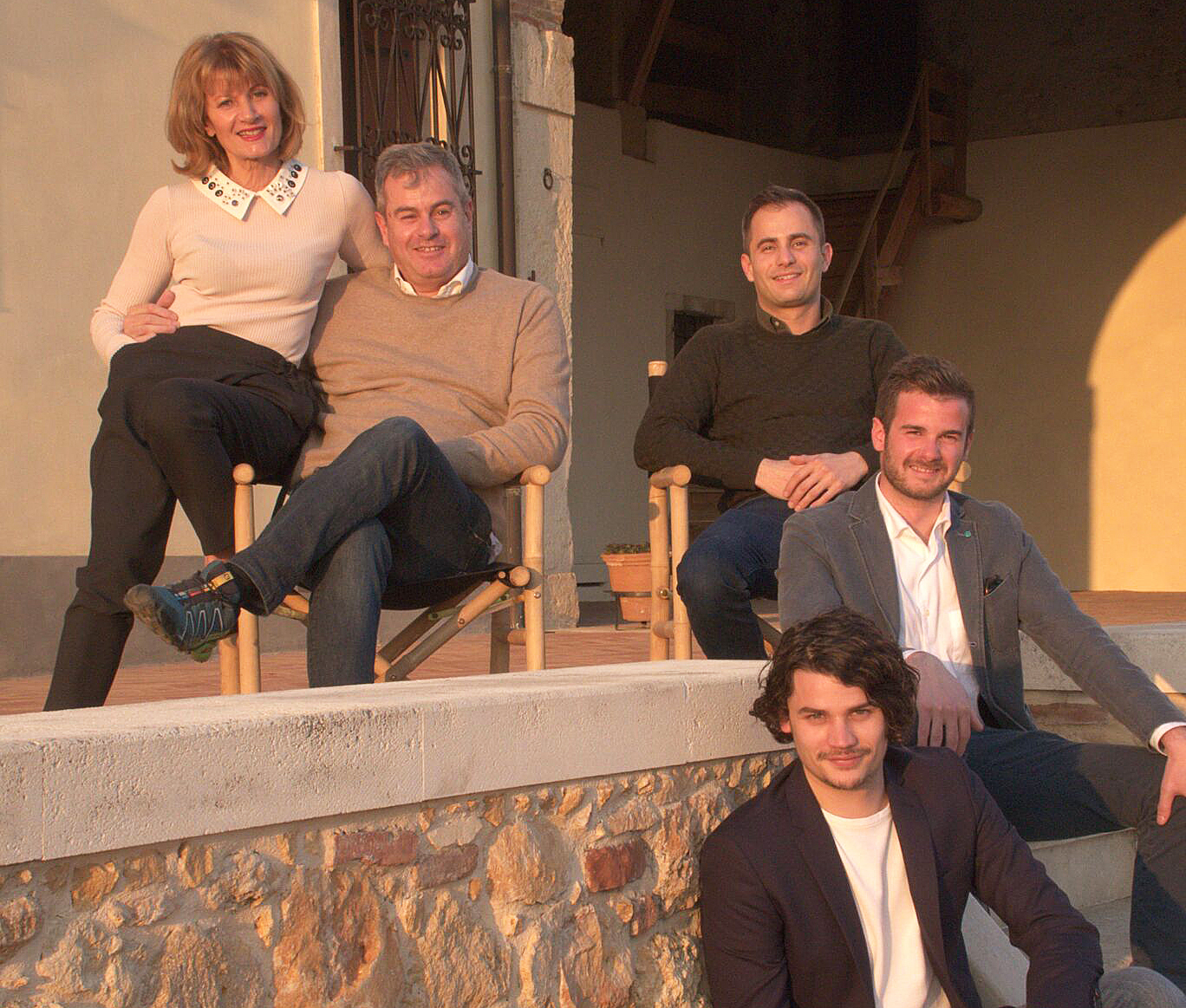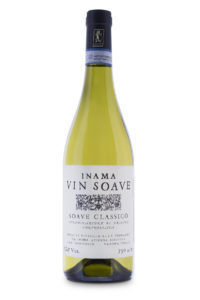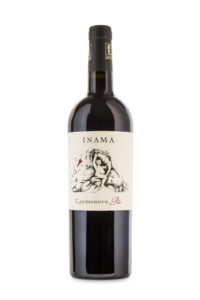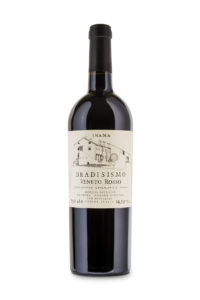A Wine Family’s Excellent Adventure: Why the Often Mishandled and Abused Soave Deserves Your Drinking Respect
BY James Brock // 08.01.18
Down this road reside some great vines. (Courtesy West Side Wines)
I would like to introduce you to a family that makes wine in the Soave region, wines that you can drink every day and introduce to your fiends and guests, who will, I assure you, be demonstratively grateful that you chose to share.
The Inamas are an attractive family, in a number of ways, and have been behind some outstanding Soave Classico for more than 40 years. Stefano is the current patriarch — his father, Giuseppe, took the family into winemaking in the 1960’s, when he bought a few small plots of land on Monte Foscarino to supply bottlers with something to make a good Soave — and lords over 70 acres of vineyards in a land where Garganega is cherished.

Garganega, you ask? Yes, it’s the sixth most widely grown grape in Italy, but many on these shores don’t know much — if anything — about it. That’s OK, however, because what follows is a *brief* primer for you, something you can pull from next time you find yourself on a bar stool exchanging words with the wine aficionado next to you, the one who “drinks nothing but Pét-Nat and Orange wines”.
Think of one word: Soave. That’s the wine behind which Garganega stands. It can be a beautiful, crisp, wine, but can also be crap if mishandled or abused, which happens too often. Garganega vines grow like kudzu, and too much fruit is not a good thing if quality is what you seek (more on that later). DNA analysis has shown that Garganega is identical to the Grecanico Dorato grape. Garganega is the key grape in Soave (along with lesser amounts of Trebbiano and Chardonnay). That’s your primer.
Now, back to the Inamas, and quality over quantity. Inama is, you see, one of the top producers of high-quality Soave, and Giuseppe and Stefano are two of the movement’s (the rescue of Soave from its undeserved crappiness) most important individuals. The elder Inama passed away in 2009, but not before growing some great Garganega and making people see that Soave could be a fine, minerally crisp wine, one that foods love.
In 1991, Stefano began bottling the family’s own estate wines — Azienda Agricola Inama is the brand — and tried his hand at Carménère, all the while growing some great Garganega. The Inama Carménère thrives in the dry and warm climate in which it’s grown (Colli Berici), and the family’s Carménère vines there date back to the 1880s. In all, Inama Colli Berici holdings comprise 60 acres; the soil is full of trace elements and minerals, the result of Bradyseism, and one can taste that in the glass.
So, Sauvignon Blanc (which first put Inama on the map, in the early 1990s) and Soave Classico in Inama’s Soave vineyards, and Carménère, Merlot, and Cabernet Sauvignon in the Colli Berici: not a bad lineup at all. I recently tasted four of Inama’s wines, and found them to be lively, rich, satisfying, and noteworthy.
Inama Soave Classico “Vin Soave” DOC 2017 (SRP $15)
Inama Soave Classico Vigneti di Foscarino DOC 2016 (SRP $25)
Inama “Carménère Piu” Veneto Rosso IGT 2015 (SRP $20)
Inama “Bradisismo” Veneto Rosso IGT 2015 (SRP $30)

To begin the summary of our tasting, the “Vin Soave” is something I could drink every day. Inama refers to it as their “entry-level wine,” and at this price point, it’s an entry-level gem. The vines that produce the grapes that go into this bottle are 30 years old, and the resulting complexity shines. While the Vin Soave constitutes half of Inama’s overall production, there is nothing approaching mass-production blandness here. The minerality is superb, and the floral notes intriguing… at one point we discerned peach, at another pear shone through.
The 100 percent Garganega delivered its trademark almond, and the acidity rang out with citrusy notes. Alcohol here is 12 percent, and the stainless-steel vinification is evident. A bright, crisp, enlivening wine, perfect with roasted snapper, pea risotto, or on its own. (We paired it with smoked salmon and some figs and Pecorino, and it sang.)
Up next, the Soave Classico Vigneti di Foscarino DOC 2016, which retails for $25. It was perhaps my personal favorite of the tasting, full of proud minerality and distinctly Garganega (that grape constitutes 100 percent of the Foscarino). Vines here are more than 40 years old, and if you appreciate a wine that expresses its terroir with grace and vigor, this is for you. Inama notes that “this is our interpretation of the Soave Classico that looks back to ancient times,” and drinking this put us squarely on Monte Foscarino. I loved the almond and white-flower notes, and the time spent in barrel adds to this wine’s richness.
Drink it now, or cellar it until 2025. Again, great with fish, and I think it would pair nicely with a lobster bisque.
We went red for our next pour, namely, to the 2015 Carménère Più (70 percent Carménère, 30 percent Merlot). Inama pioneered this grape in the Collo Berici area, and what they have done is simply delicious. (Carménère is a fascinating grape, and I urge you to learn more about it. It originated in Bordeaux, and was primarily used as a blending grape. When phylloxera hit and wreaked its devastation, vignerons in Bordeaux chose against replanting Carménère, focusing instead on Cabernet Sauvignon and Merlot. In Chile, however, Carménère tells another story. Wine for Normal People has this piece on the grape, which I offer for your edification.)
Inama’s foray into Carménère is now the stuff of legend, because it is really good wine. I’ll let Stefano say a few words about his project:
“The idea of producing a great and unique red wine, typical of the Berici Hills, made from a selection of Carménère grapes, came to mind when we first saw the area around the old Oratorio di San Lorenzo at San Germano dei Berici (province of Vicenza). This was back in 2001,” the winemaker wrote. “It is a small valley, probably of Karst origin, halfway up the hills on the right-hand side of Val Liona. Actually, in our opinion, it is exactly here, on the Berici Hills just south of Vicenza, geologically formed by an ancient bradyseism, that Carménère has found its ideal area.”
In 2009, Carménère officially became a Colli Berici DOC wine.

Ideal, indeed. The Più — the word means “more” in Italian — is supple, boasts a hint of spiciness, and drinks like a much more expensive wine (it retails for around $20). It spends 12 months in used oak, and possesses a balance to die for. It is unfined, and is 100 percent unstemmed. Open this, let it breathe for 20 minutes, slice a salami, and have a wonderful interlude. We tasted it with the very thing, a dried salami, and enjoyed it immensely. You’ll note cherry, a touch of wet hay, and cocoa, and I wager that you’ll buy more than one bottle.

Finally, the Bradisismo, named after the geological phenomenon that created the Colli Berici. This is Inama’s Classic Reserva. First vintage was 1997, and the 2015 is 70 percent Cabernet Sauvignon and 30 percent Carménère. The grapes used here are picked by hand, and the care shows in the bottle. Vines are planted (mainly) in clay and limestone, and the grapes are destemmed, crushed, and treated to 12 days of skin contact. Fifteen months in 50 percent new and 50 percent used barriques follow.
On the nose, we got dark cherry, plum, and leather, and the still-young tannins promise even better drinking in five (or more) years. As with the Più, the sausage loved this wine, and I’m going to open a bottle the next time I eat brisket. This is a serious red, so grilled steaks and lamb are other wise pairings.
Here’s a look at Stefano discussing the wine:
We tasted four fine bottles on the day, and while the Bradisismo could perhaps use another year or two in the bottle, they are all drinking beautifully now. The Inama family continues to create great wines, and that’s nothing but good.
(Inama wines are imported to the U.S. exclusively by Dalla Terra Winery Direct.)
Want more wine stories? Check out PaperCity’s grape and spirits library:
Your Endless Crush Rosé
Enrique Varela Loves Malbec
This Geologist Knows His Italian
A Chardonnay For Your Mother (and You)
Don’t Dismiss the Peat
Distinctive Whisky Enters a New Era
A Whisky Legend Visits Houston
A Rare Cask, Indeed
Austin Whisky, Strange Name
Here’s Your Texas Rum Goddess
A ZaZa Wine Guy Loves Great Service
A Merlot That Your Snob Friend Will Love
French Couple Make a Sauvignon Blanc in California
A Perfect Afternoon Chardonnay
Terry Theise Talks Reisling
A New Wine Wonderland
Paris Wine Goddess Tells All
Rice Village Wine Bar Has a Cleveland Touch
A Texas White Blend for Your Table
A Pinot Noir Full of Flavor
This Pinot Gris From Oregon Pairs Well With Cheese
Willamette, Dammit!
A Value Rioja
Drink Pink!
Underbelly Veteran Goes for Grenache
A Man of Letters and Wine
Ms. Champagne Wants a Nebuchadnezzar
The Wine Artist Goes for Chardonnay
This American Loves Spain and Its Wines
Houston’s Wine Whisperer Has a Soft Touch
Blackberry Farm’s Somm Pours in Splendor
Mr. Pinot Noir: Donald Patz of Patz & Hall
A Cork Dork Wants to Spend More Time in Tuscany
Sommelier Turned Restaurateur Daringly Goes Greek
Texas Master Sommelier Debunks Wine Geeks
A Bottle From Gigondas Changed This Houston Man’s Life
Oil Man Falls in Love, and the Rest is Good-Taste History
Ryan Cooper of Camerata is a Riesling Man
Mixing It Up With Jeremy Parzen, an Ambassador of Italy
Sommelier at One of Houston’s Top Wine Bars Loves Underdogs










_md.jpg)







